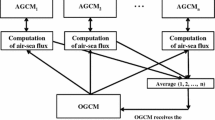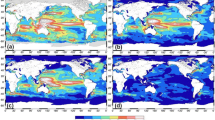Abstract
Total sea surface temperature (SST) in a coupled GCM is diagnosed by separating the variability into signal variance and noise variance. The signal and the noise is calculated from multi-decadal simulations from the COLA anomaly coupled GCM and the interactive ensemble model by assuming both simulations have a similar signal variance. The interactive ensemble model is a new coupling strategy that is designed to increase signal to noise ratio by using an ensemble of atmospheric realizations coupled to a single ocean model. The procedure for separating the signal and the noise variability presented here does not rely on any ad hoc temporal or spatial filter. Based on these simulations, we find that the signal versus the noise of SST variability in the North Pacific is significantly different from that in the equatorial Pacific. The noise SST variability explains the majority of the total variability in the North Pacific, whereas the signal dominates in the deep tropics. It is also found that the spatial characteristics of the signal and the noise are also distinct in the North Pacific and equatorial Pacific.
Similar content being viewed by others
References
Alexander, M.A. 1992. Midlatitude atmosphere-ocean interaction during El Nino, I. The North Pacific Ocean.J. Climate,5, 944–958.
Barnett, T.P., D.W. Pierce, R. Saravanan, N. Schneider, D. Dommenget, and M. Latif. 1999. Origins of the midlatitude Pacific decadal variability.Geophys. Res. Lett.,26, 1454–1456.
Battisti, D.S., U.S. Bhatt, and M.A. Alexander. 1995. A modeling study of interannual variability in the wintertime North Atlantic Ocean.J. Climate,8, 3067–3083.
Briegleb, B.P. 1992. Delta-Eddington approximation for solar radiation in the NCAR community climate model.J. Geopys. Res.,97, 7603–7612.
Davis, R.E. 1976. Predictability of sea surface temperature anomalies and sea level pressure anomalies over the North Pacific ocean.J. Phys. Oceanogr.,6, 249–266.
Delworth, T. 1996. North Atlantic interannual variability in a coupled ocean-atmosphere model.J. Climate,9, 2356–2375.
DeWitt, D.G. 1996. The effect of the cumulus convection on the climate of the COLA general circulation model. COLA Tech. Rep. 27. 69 p.
DeWitt, D.G. and E.K. Schneider. 1996. The Earth radiation budget as simulated by the COLA GCM. COLA Tech. Rep. 35. 39 p.
Frankignoul, C. and K. Hasselmann. 1977. Stochastic climate models: Part I. Application to sea surface temperature anomalies and thermocline variability.Tellus,29, 289–305.
Gent, P.R. and J.C. McWilliams. 1990. Isopycnal mixing in ocean circulation models.J. Phys. Oceanogr.,20, 150–155.
Hannachi, A. 2001. Toward a nonlinear identification of the atmospheric response to ENSO.J. Climate,14, 2138–2149.
Hasselmann, K. 1976. Stochastic climate models: Part I. Theory.Tellus,28, 473–485.
Harshvardhan, R.R. Davis, D.A. Randall, and T.G. Corsetti. 1987. A fast radiation parameterization for general circulation models.J. Geophys. Res.,92, 1009–1016.
Harzallah, A. and R. Sadourny. 1995. Internal versus SST-forced atmospheric variability as simulated by an atmospheric general circulation model.J. Climate,8, 474–495.
Hoerling, M.P., A. Kumar, and M. Zhong. 1977. El Nino, La Nina, and the nonlinearity of their teleconnections.J. Climate,10, 1769–1786.
Kiehl, J.T., J.J. Hack, and B.P. Briegleb. 1994. The simulated earth radiation budget of the National Center for Atmospheric Research community climate model CCM2 and comparisons with the Earth Radiation Budget Experiment (ERBE).J. Geophy. Res.,99, 20815–20827.
Kinter, J.L. III, J. Shukla, L. Marx, and E.K. Schneider. 1988. A simulation of winter and summer circulations with the NMC global spectral model.J. Atmos. Sci.,45, 2468–2522.
Kirtman, B.P. and J. Shukla. 2002. Interactive coupled ensemble: A new coupling strategy for CGCMs.Geophys. Res. Lett.,29, 1029–1032.
Kirtman, B.P., Y. Fan, and E.K. Schneider. 2002. The COLA global coupled and anomaly coupled ocean-atmosphere GCM.J. Climate,15, 2301–2320.
Kirtman, B.P. and S. Zebiak. 1997. ENSO simulation and prediction with a hybrid coupled model.Mon. Wea. Rev.,125, 2620- 2641.
Large, W.G., J.C. McWilliams, and S.C. Doney. 1994. Oceanic vertical mixing: A review and a model with a nonlocal boundary layer parameterization.Rev. Geophys.,32, 363–403.
Latif, M. and T.P. Barnett. 1994. Causes of decadal climate variability over the North Pacific and North America.Science,266, 634–637.
Miller, A.J., D.R. Cayan, and W.B. White. 1998. A westward- intensified decadal change in the North Pacific thermocline and gyre-scale circulation.J. Climate,11, 3112–3127.
Miyakoda, K. and J. Sirutis. 1977. Comparative integrations of global spectral models with various parameterized processes of sub-grid scale vertical transport.Beitr. Phys. Atmos.,50, 445–480.
Moorthi, S. and M.J. Suarez. 1992. Relaxed Arakawa-Schubert: A parameterization of moist convection for general circulation models.Mon. Wea. Rev.,120, 978–1002.
Nakamura, H., G. Lin, and T. Yamagata. 1997. Decadal climate variability in the North Pacific during the recent decades.Bull. Amer. Meteor. Soc.,78, 2215–2225.
Pacanowski, R.C., K. Dixon, and A. Rosati. 1993. The GFDL modular ocean model users guide, version 1.0. GFDL Ocean Group Tech Rep. No. 2. 77 p.
Pacanowski, R.C. and S.M. Griffies. 1998. MOM 3.0 manual. NOAA/Geophysical Fluid Dynamics Laboratory. 638 p.
Redi, M.H. 1982. Oceanic isopycnal mixing by coordinate rotation.J. Phys. Oceanogr.,12, 1155–1158.
Reynolds, R. and T. M. Smith. 1994. Improved global sea surface temperature analysis using optimum interpolation.J. Climate,7, 929–948.
Robertson, A.W. 1996. Interdecadal variability over the North Pacific in a multi-century climate simulation. ClimateDyn.,12, 227–241.
Rosati, A. and K. Miyakoda. 1988. A general circulation model for upper ocean circulation.J. Phys. Oceanogr.,18, 1601–1626.
Rowell, D.P. 1998. Assessing potential seasonal predictability with an ensemble of multidecadal GCM simulations.J. Climate,11, 109–120.
Saravanan, R. 1998. Atmospheric low-frequency variability and its relationship to midlatitude SST variability: Studies and the NCAR Climate System Model.J. Climate,11, 1386- 1404.
Saravanan, R. and J.C. McWilliams. 1995. Multiple equilibria, natural variability, and climate transitions in an idealized ocean-atmosphere model.J. Climate,8, 2296–2323.
Schneider, E.K. 2002. Causes of differences between the equatorial Pacific as simulated by two coupled GCMs.J. Climate,15, 2301–2320.
Seager, R., Y. Kushnir, N.H. Naik, M.A. Cane, and J. Miller. 2001. Wind-driven shifts in the latitude of the Kuroshio- Oyashio extension and generation of SST anomalies on decadal timescales.J. Climate,15, 4249–4265.
Shukla, J. and co-authors. 2000. Dynamical seasonal prediction.Bull. Amer. Meteor. Soc.,81, 2593–2606.
Smagorinsky, J. 1963. General circulation experiments with the primitive equations. I. The basic experiment.Mon. Wea. Rev.,91, 99–164.
Straus D.M. and J. Shukla. 2000. Distinguishing between the SST-forced variability and internal variability in mid-latitudes: Analysis of observation and GCM simulations.Quart. J. Roy. Meteorol. Soc.,126, 2323–2350.
Tanimoto, Y., N. Iwasaka, and K. Hanawa. 1997. Relationships between sea surface temperature, the atmospheric circulation and air-sea fluxes on multiple timescales.J. Meteor. Soc. Jpn.,75, 831–849.
Yeh, S.-W. and Ben P. Kirtman. 2004. The impact of internal atmospheric variability on the North Pacific SST variability.Climate Dyn.,22, 721–732.
Zhang, Y., J.M. Wallace, and D.S. Battisti. 1997. ENSO-like interdecadal variability: 1900-93.J. Climate,10, 1004–1020.
Zwiers, F.W. 1996. Interannual variability and predictability in an ensemble of AMIP climate simulations conducted with the CCC GCM2.Climate Dyn.,12, 825–847.
Author information
Authors and Affiliations
Corresponding author
Rights and permissions
About this article
Cite this article
Yeh, SW., Kirtman, B.P. The characteristics of signal versus noise sst variability in the north pacific and the tropical pacific ocean. Ocean Sci. J. 41, 1–10 (2006). https://doi.org/10.1007/BF03022401
Received:
Revised:
Accepted:
Issue Date:
DOI: https://doi.org/10.1007/BF03022401




